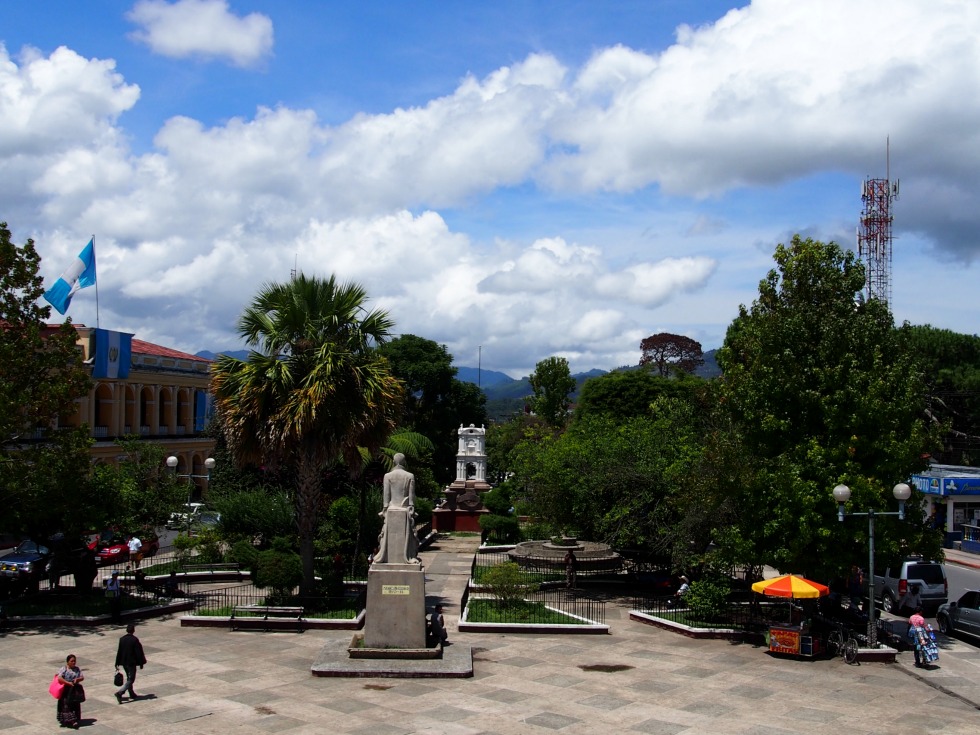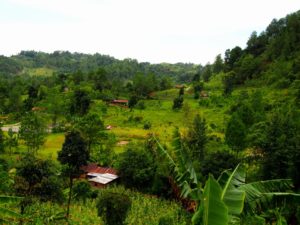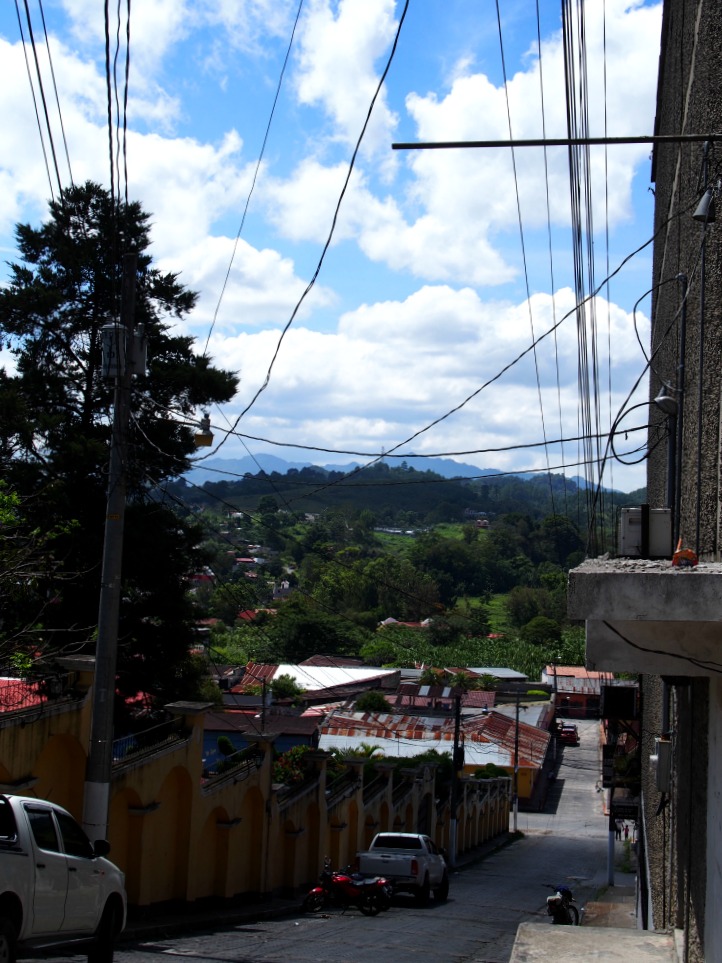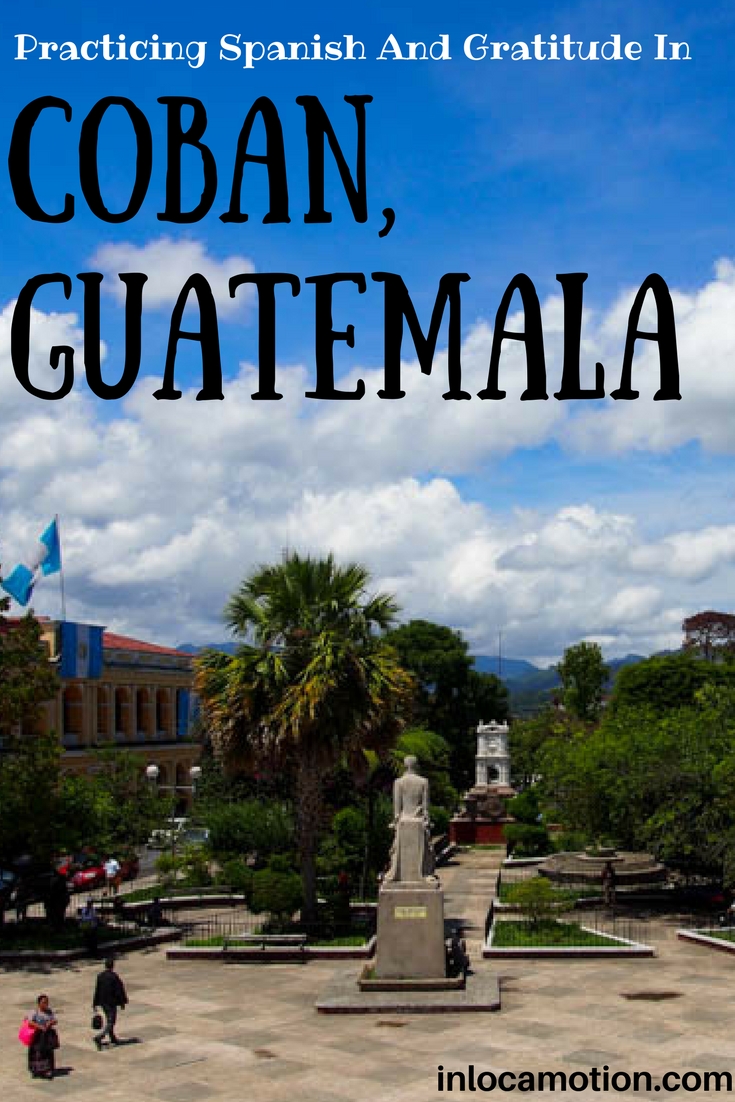
View of the parque central in Cobán as the clouds come in for the afternoon
Of everywhere that I visited in Guatemala, Cobán was my favorite. It ended up being a destination by chance, and arriving there was a journey. I traversed Guatemala City in search of the minibus that would take me to the small city of Cobán, and then spent four hours crammed, immobile, in the back corner of the hot, crowded bus. Originally, I was just planning on passing through Cobán. A pitstop on my way to Semuc Champey.
But I never made it to Semuc Champey. It’s rumored to be beautiful, a landmark containing natural limestone pools. It was (and still is) on my list of places to see. But by the time I made the long, hot minibus journey up to Cobán, I found out that the site I had come to see was closed due to protests. Regardless, I spent an unexpected five days in Cobán. I was super comfortable in my hostel, the Hostal Casa Luna, where the owners took me in like family. I spent my days wandering around the city, hopping on the local buses and taking little trips to the villages and sites in the Alta Verapaz. I forged friendships in Cobán, with kind people who I am still in contact with, many months later. Needless to say, Cobán was good to me, and the highlight of my trip to Guatemala.

View of the countryside of the Alta Verapaz region of Guatemala
My second evening in Cobán, after a morning spent wandering through the Grutas del Rey Marcos, and an afternoon spent journaling and hammock-lounging during the mid-day rainstorm (I know, I am blessed), I emerged from my hostel come sundown in search of dinner. I turned in the direction of Cobán’s parque central, passing tiendas and street food vendors, pedestrians and motociclistas. I had very little on my agenda for the evening. My time in Cobán was my time for relaxation. Mid-week, there was little going on in terms of nightlife in the small city. Mid-September, the daily rain in Guatemala kept tourism at a minimum. I had learned my lesson the previous night, in which I fruitlessly searched for a place to go see a band play cumbia music en vivo. (My first night in Cobán was a Wednesday, and I found out the hard way that mid-week there was no live cumbia to be found.) So my expectations for my second night were simple – I would treat myself to a sit-down meal, and then I would return to my hostel and get a good night’s sleep.
I walked beyond the parque central and poked my head into various restaurants. Finally, I settled on a creperie (not very Guatemalan, I know, but at the very least I ordered myself a crepe with frijoles negros). The restaurant was large, with many tables spread throughout its large patio. The majority of the patio was covered by a pitched canopy roof, but as is common in Guatemala, in the center of the roof was a large opening that exposed the interior to the elements. Sunshine, the mid-afternoon rain, the cool night air.
I sat down by myself at a table under the roof, wary of getting rained on in the center of the restaurant. There were only a few other patrons scattered throughout the restaurant. My waiter came over to the table. He was a young, cute Guatemalan guy. I ordered a Gallo and a few minutes later he brought it over to me. I had a split second to make conversation – the guy was working, after all, but I was having one of those moments in which I wanted to connect with another human being. So I decided to start with, “¿De dónde eres?” (Where are you from?)
“De aquí, Cobán,” he responded with a smile, like it should have been obvious. Hey, you never know.
I asked him if he could teach me a new word in Guatemalan Spanish. Una palabra típica de aquí. The waiter scratched his head, thinking. He wasn’t sure! I smiled and thanked him, and then figured I would stop pestering the guy. He left and I sipped my Gallo, both hungry and tranquil.
Shortly afterwards, my waiter returned and brought me my food, and I ate in contemplative silence. Meanwhile, my waiter and two of his colleagues convened around the front counter, on the other side of the restaurant. I couldn’t discern exactly what they were staying, but they were having a boisterous conversation, full of excited Spanish and bubbles of laughter. I glanced their way, curious.
I took my time with my meal, slowing filling myself with black beans and cheese. All the while, the conversation continued around the front counter. Lots of emotion, carcajadas, bulla. I finished eating, and a few minutes later my waiter came back over to the table. He took my plate, and then he handed me a napkin, which had words scrawled out on both sides. He just smiled at me before walking away. I studied the napkin in shock.
Because, you see, it wasn’t just any old napkin. And the words written all over it weren’t just any old words. Now I understood what all of the excitement had been about on the other side of the restaurant. Now I understood the laughter and the excited Spanish. Because they had given me this:

The two sides of the servilleta
I sat there, stupefied, reading the napkin. The left-most words or phrases on each side of the napkin were Guatemalan words; the right side were their translations into universal Spanish. I let each word pass through my head, almost found it on the tip of my tongue. I had heard a few of the words since arriving in Guatemala approximately two weeks beforehand, but the majority were new. As I read through the napkin – front and back, again and again – I couldn’t keep a smile off of my face. I felt so humbled, and so flattered, and so touched.
When my waiter returned, I thanked him profusely. I paid and made my way back to my hostel, all the while practically reverberating from such a simple and not so simple act that had absolutely made my night.
It’s amazing the gifts that humans are capable of giving each other. I don’t know if the man who served me that night knows what a remarkable feeling it was (and still is), to have been given something so thoughtful, personal, and relevant. I still have this napkin, tucked safely into a journal in my home in Baltimore. It’s a tangible representation of my crash-course in Guatemalan Spanish, and of the kindness of strangers.
When I returned to my hostel, still bubbling with joy from the interaction in the restaurant, I excitedly showed the napkin to one of the guys who works there. “Look! I went to dinner and the restaurant staff gave me this! Isn’t this so awesome?”
He grinned and sat down next to me, curiously perusing the napkin. He went through the napkin line by line. “Yeah, I use this one, and this one… I don’t use this one. Esto,” he said, referring to the gift as a whole, “es muy bueno.”
He pointed out two of the words – ixto and xute – and explained to me that in his hometown in the southwest of Guatemala, words with x’s like these are not common. According to him, in the western portion of Guatemala, there is more influence from Mexican Spanish. As opposed to in Cobán, in which there is more influence from the Mayan languages – thus words like ixto, pronounced ‘ishto’. I shouldn’t have been surprised. Not only do Spanish-speaking countries have their own unique sets of vocabulary, but the regional differences in the Spanish language within a given country can be quite striking. Guatemala is no exception.

Urban foreground and mountainous background of Cobán, Guatemala
Spanish is a truly rich and phenomenal language. Regardless of whether you are a native speaker or are learning Spanish as a second (or third, forth, fifth, etc.) language, there is always something more to learn. I have had plenty of conversations full of shock and delighted laughter when, in comparing some word or phrase from one country to another, we realize that a word that is commonplace in Spain is completely inappropriate in Guatemala, or that a pet name from the Dominican Republic is actually quite vulgar in Colombia. Spanish from Latin America is different from Spanish from Spain, Spanish from Central America is different from Spanish from South America, Spanish from Peru is different from Spanish from Chile is different from Spanish from Honduras. In some places you can drive one hour away to the next town over and encounter a completely different set of regionalisms and vocabulary. Depending on who you ask, the answer to the question “how do you say ‘beans’ in Spanish?” could probably yield about ten different answers. And so on, and so forth. The Spanish language is dynamic, diverse, and complex.
As a tourist who likes to frequent Latin America, I believe that a knowledge of Spanish is critical. I encourage everyone who travels or will travel in Spanish-speaking countries to learn as much as possible about the Spanish language. Language opens doors and allows us to have a better understanding of the cultures that we are consuming as tourists. Language allows us to discuss, critique, and exchange our own cultures with the people we meet while abroad. It helps us ask better questions and see people more fully. When we make the effort to speak another person’s native language, it allows us to see that person at the height of their self-expression. That’s a beautiful thing.
Speak Spanish in Latin America. Make mistakes, try anyway, laugh through the embarrassment of accidentally saying the completely wrong thing. Listen actively, ask questions, practice gratitude, y siempre di gracias.
How do you say beans in Spanish? What have been your experiences (good or bad) with language integration, in Spanish or English or any language that is not your native tongue? Is language learning a priority for you when you travel? Let me know in the comments below!










8 comments
Hello fellow Baltimore blogger! I had a great time in Guatemala a few years ago. My Spanish is pretty rusty but I always use it. If another language is used I try to learn at least a few key phrases or words to be polite and keep my brain sharp 🙂
I think that even knowing a few words and phrases goes a long way! People tend to be appreciative of foreigners making the effort to communicate in the native language of a country. Even if I don’t know a single word of the language in a given country, I try to pick up as much as I can while I’m there. It’s a great way to engage with locals, plus it’s fun! 🙂 Thanks for reading and commenting, Andrea!!
This was great! Learning languages is challenging but it can be a lot of fun, and mostly, natives love teaching you their language. I know that as a second language learner it can be super difficult to work up the courage to make mistakes when you’re learning a new language, but it’s so worth it because you can gain so much from being able to converse with locals!
I agree 100%! Language learning opens so many doors. It’s a huge priority for me when I travel. Thanks for reading and commenting, Nina!!
My most memorable “language barrier” story I have from my travels was my trip to Greece years ago. I was on the party island of Mykonos. Since my two friends were tired from the sun and drinking all day, they headed back to the hotel to take a nap before heading off for dinner while I stayed to enjoy a few more beers.
At the corner of my eye were two cute women sitting at the beach bar that I was at. I casually sat down beside them and ordered a drink. Then I got to talking with them realizing that they were from Italy and spoke practically no English. With my knowledge for Canadian-French, I was able to figure out that they both loved Manchester United, were from Rome, and one was a Doctor and the other a Lawyer. Eventually, we ended up going to a restaurant for a late dinner and spent the next 2 – 3 hours getting to each other.
Around 11pm, I went back to my hotel where my two buddies were waiting for me wondering where I was the entire time. I told them about the Italian women, whom we eventually ended up meeting in downtown Mykonos around 2am. We stayed out until Sunrise partying with them even though my friends couldn’t understand a word they were saying. They were impressed that I could get these women to come out with us and buy us drinks all night because I was so friendly with them earlier. I was just impressed that I could remember Canadian-French at the drop of a hat while intoxicated and not having spoken a word of it since my last high school French class 10 years earlier.
The point of my story is that I can totally relate and understand how you must of felt here at this restaurant connecting with someone over a foreign language. You definitely got a life lesson here that you would have missed out on if Semuc Champey was actually open!
Thanks for sharing your experience with languages during your travels! It’s also amazing how a few words here or there in a language can get you a long way, especially if there is a lot of crossover between languages (so getting between English, Italian, and French might be a little easier than, say, getting between English and Mandarin). And I agree, I definitely got a great experience by staying in Coban and not continuing on to Semuc. I’m very happy about how everything panned out!
This is such a lovely encounter! I’m learning Spanish now (living in Mexico) and when local people help me to better understand it, it is SO nice. Knowing the local language wherever you are is always helpful, it leads to stories like this! Thanks for sharing 🙂
Aw, thanks so much for your kind comment, Laura! And good luck with your Spanish learning in Mexico!!